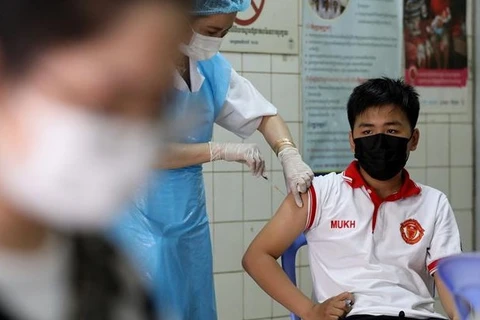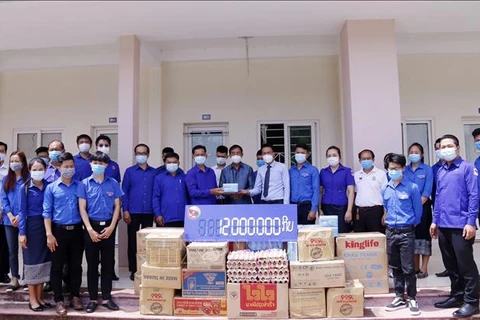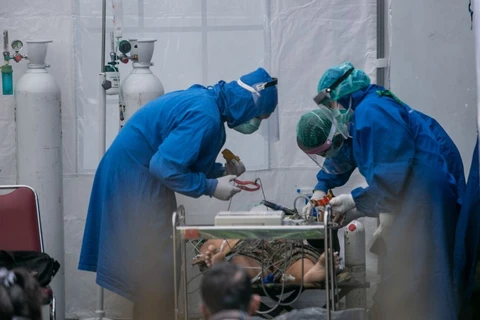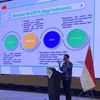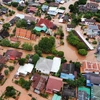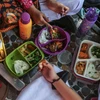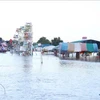Hanoi (VNA) – The Lao Ministry of Health reported on August 2 that the country had recorded an additional 199 COVID-19 infections over the past 24 hours, raising the national count to 6,765, including seven fatalities.
Prime Minister Phankham Viphavanh has instructed southern provinces to improve the capacity of and open more quarantine centres and hospitals to handle the expected influx of more migrant workers from neighbouring countries.
Earlier, 3,000 more medical workers from hospitals in Vientiane were deployed to provinces with high numbers of returnees and COVID-19 cases.
Laos also began using Johnson& Johnson’s vaccine against COVID-19 to inject its people, especially those with high risks, including the elderly aged above 60 and those with underlying diseases.
Also on August 2, Cambodia recorded 560 new COVID-19 infections and 22 deaths, bringing the total counts to 78,474 and 763, respectively.
Cambodia started its mass COVID-19 vaccination campaign on February10, with the aim of having 12 million people (75 percent of its population) vaccinated before November. To date, about 7.38 million people have received at least one dose.
The same day, a mass COVID-19 vaccination campaign was conducted in Klang Valley, the hardest-hit region in Malaysia’s COVID-19 outbreak.
This is the latest move of the Malaysian government towards the goal of having 80 percent of its population inoculated by the end of 2021.
Meanwhile, Singapore’s Ministry of Health (MOH) said on August 1 that the nation will tighten border measures for travellers from Australia or China’s Jiangsu province after those places saw surges in COVID-19 cases. The new measures will start on August 2 at 11.59pm.
Incoming travellers - with a travel history to Australia within the last 21 days - will have to serve a 14-day stay-home notice (SHN), up from seven days, the ministry said. They will have to do so in either a dedicated facility or at their places of residence.
Those who opt for their place of residence must be staying there alone, or with household members with the same SHN duration and travel history. They must also have travelled to no other region within the last 21 days.
Meanwhile, incoming Singapore citizens, permanent residents and long-term pass holders with travel history to China's Jiangsu province within the last 21 days will have to serve a seven-day SHN at their places of residence.
They will have to take a COVID-19 polymerase chain reaction (PCR) test on arrival and before the end of their isolation.
Travellers from other parts of China are allowed to go about their activities in Singapore without having to serve an SHN if their PCR test on arrival is negative.
Short-term travellers with an air travel pass with travel history to Jiangsu province within the last 21 days will not be allowed to enter Singapore./.
Prime Minister Phankham Viphavanh has instructed southern provinces to improve the capacity of and open more quarantine centres and hospitals to handle the expected influx of more migrant workers from neighbouring countries.
Earlier, 3,000 more medical workers from hospitals in Vientiane were deployed to provinces with high numbers of returnees and COVID-19 cases.
Laos also began using Johnson& Johnson’s vaccine against COVID-19 to inject its people, especially those with high risks, including the elderly aged above 60 and those with underlying diseases.
Also on August 2, Cambodia recorded 560 new COVID-19 infections and 22 deaths, bringing the total counts to 78,474 and 763, respectively.
Cambodia started its mass COVID-19 vaccination campaign on February10, with the aim of having 12 million people (75 percent of its population) vaccinated before November. To date, about 7.38 million people have received at least one dose.
The same day, a mass COVID-19 vaccination campaign was conducted in Klang Valley, the hardest-hit region in Malaysia’s COVID-19 outbreak.
This is the latest move of the Malaysian government towards the goal of having 80 percent of its population inoculated by the end of 2021.
Meanwhile, Singapore’s Ministry of Health (MOH) said on August 1 that the nation will tighten border measures for travellers from Australia or China’s Jiangsu province after those places saw surges in COVID-19 cases. The new measures will start on August 2 at 11.59pm.
Incoming travellers - with a travel history to Australia within the last 21 days - will have to serve a 14-day stay-home notice (SHN), up from seven days, the ministry said. They will have to do so in either a dedicated facility or at their places of residence.
Those who opt for their place of residence must be staying there alone, or with household members with the same SHN duration and travel history. They must also have travelled to no other region within the last 21 days.
Meanwhile, incoming Singapore citizens, permanent residents and long-term pass holders with travel history to China's Jiangsu province within the last 21 days will have to serve a seven-day SHN at their places of residence.
They will have to take a COVID-19 polymerase chain reaction (PCR) test on arrival and before the end of their isolation.
Travellers from other parts of China are allowed to go about their activities in Singapore without having to serve an SHN if their PCR test on arrival is negative.
Short-term travellers with an air travel pass with travel history to Jiangsu province within the last 21 days will not be allowed to enter Singapore./.
VNA

